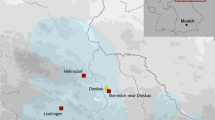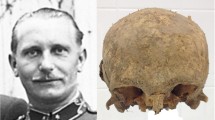Abstract
During the reconstruction of the cellars of a house in Staňkova Street in Brno (Czech Republic), the human skeletal remains of 12 individuals stored in a common grave pit were discovered. By its arrangement, this grave corresponded to mass burials during war conflicts, epidemics or famines. Using the radiocarbon method, the skeletons were dated to the early nineteenth century, when the Napoleonic Wars took place in Central Europe. A detailed analysis of the osteological collection revealed that young men aged from 20 to 30 years, with an average body height of 167.6 cm, were buried in the grave. On one of the skeletons, a comminuted fracture of the humerus was recorded, probably caused by a gunshot wound; on another, there were visible traces of a surgical procedure — amputation. From the results of the examination, it is possible to assume that these were soldiers who had died in a temporary field hospital. The hypothesis was confirmed by the analysis of dental calculus, in which traces of sulphur and nitrogen were found, which are components of gunpowder. Degenerative changes in the spine and bones of the lower limbs also indicate a huge physical strain when carrying heavy weapons during long marches in heavy military footwear. Genetic determination of the mitochondrial DNA haplogroups revealed three different haplogroups that occur with different frequencies in different parts of Europe. So it is probable that victims of the Battle of the Three Emperors, which took place in nearby Austerlitz (Slavkov u Brna) on 2 December 1805, were buried in the mass grave under study.















Similar content being viewed by others
References
Acsádi G, Nemeskéri J (1970) History of human life span and mortality. Akadémiai Kiadó, Budapest
Amort Č (1971) Kutuzov a Napoleon na Moravě (Kutuzov and Napoleon in Moravia). Horizont, Praha
Andrews RM, Kubacka I, Chinnery PF et al (1999) Reanalysis and revision of the Cambridge reference sequence for human mitochondrial DNA. Nat Genet 23:147
Aufderheide AC, Rodríguez-Martín RC (1998) The Cambridge encyclopedia of human paleopathology. Cambridge University Press, Cambridge
Bláha R (1963) Rentgenologie kostí a kloubů I (Radiology of bones and joints I). Státní zdravotnické nakladatelství, Praha
Bohunová M (2003) Válečný pohřební ritus (War funeral rite). Dissertation, Masaryk University
Brothwell D (1972) Palaeodemography and earlier British populations. World Archaeol 4:75–87
Buikstra JE, Ubelaker DH (1994) Standards for data collection from human skeletal remains: proceedings of a seminar at the Field Museum of Natural History organized by Jonathan Haas. Arkansas Archeological survey, Fayetteville, Arkansas
Caselitz P (1998) Caries – ancient plaque of humankind. In: Alt KV, Rösing FW, Teschler-Nikola M (eds) Dental anthropology. Fundamentals, limits, prospects, Springer Verlag, Wien, New York.
de Gassendi JJB (1819) Aide-mémoire à l’usage des officiers d’artillerie de France attachés au service de terre. Magimel Anselin et Pochard, Paris
Dubut V, Chollet L, Murail P et al (2004) mtDNA polymorphisms in five French groups: importance of regional sampling. Eur J Hum Genet 12:293
El Najjar MY, De Santi M, Ozebek L (1978) Prevalence and possible etiology dental enamel hypoplasia. Am J Phys Anthropol 48:185–192
Eupedia (2021) https://www.eupedia.com/ Accessed 2021
Fialová D, Skoupý R, Drozdová E et al (2017) The application of scanning electron microscopy with energy-dispersive X-ray spectroscopy (SEM-EDX) in ancient dental calculus for the reconstruction of human habits. Microsc Microanal 23:1207–1213. https://doi.org/10.1017/S1431927617012661
Fryščok MA (2000) Vojenské hroby a památníky města Brna (Military graves and monuments of the city of Brno). Brno.
Fujita H (2015) Oral health from dental paleopathology. In: Virdi MS (ed) Emerging trends in oral health sciences and dentistry. InTech. https://www.intechopen.com/books/emerging-trends-in-oral-health-sciences-and-dentistry Accessed 2021
Goff JD, Crawford R (2011) Diagnosis and treatment of plantar fasciitis. Am Fam Physician 84:676–682
Horáčková L, Vargová L (1999) Bone remains from a common grave pit from the battle of Austerlitz (anthropology and paleopathology). Journal of Paleopathology 11:5–13
Horáčková L, Strouhal E, Vargová L (2004) Základy paleopatologie (Basics of paleopathology). Panoráma biologické a sociokulturní antropologie. Nadace Universitas Masarykiana, Edice Scientia, Brno
Kopecký F (2009) O slavkovské bitvě: dopady a tradice (About the Battle of Austerlitz: impacts and traditions). Onufrius
Kovárník J, Horáčková L, Vargová L et al (2006) Hromadné hroby vojáků na Brněnské ulici z bitvy u Znojma v roce 1809 (Mass graves of soldiers on Brněnská street from the battle of Znojmo in 1809). Ve službách archeologie VII:313–328
Lebedinskaya GV (1998) Rekonstrukcija lica po čerepu. Staryj Sad, Moskva
Lovejoy CO (1985) Dental wear in the Libben population: its pattern and role in the determination of adult skeletal age at death. Am J Phys Anthropol 68:47–56
Malyarchuk B, Grzybowski T, Derenko M et al (2008) Mitochondrial DNA phylogeny in eastern and western Slavs. Mol Biol Evol 25:1651–1658
Martin R, Saller K (1957) Lehrbuch der Anthropologie in systematischer Darstellung, 3. Aufl. Band I. Gustav Fischer Verlag, Stuttgart
McKern TW, Stewart TD (1957) Skeletal age changes in young American males. Quartermaster Research and Development Center, US Army, Technical Report EP–45, Natick
Murail P, Brůžek J, Houet F, Cunha E (2005) DSP: a tool for probabilistic sex diagnosis using worldwide variability in hip-bone measurements. Bull Mém Soc Anthropol Paris 17:167–176
Novotný V (1985) Determination of sex from Talus and Calcaneus. Scr Med (Brno) 58:437
Olivier G (1960) Practique anthropologique. Vigot Fréres, Paris
Ortner DJ (2003) Identification of pathological conditions in human skeletal remains. Academic Press, London
Ortner DJ, Putschar GJ (1985) Identification of pathological conditions in human skeletal remains. Smithsonian Institution Press, Washington
Pigeard A (2021) La conscription sous le Premier Empire. Available from: https://www.napoleon.org/histoire-des-2-empires/articles/la-conscription-sous-le-premier-empire/ Accessed 2021
Reid DJ, Dean MC (2000) Brief communication: The timing of linear hypoplasias on human anterior teeth. Am J Phys Anthropol 113:135–139
Richard C, Richard C, Pennarun E et al (2007) An mtDNA perspective of French genetic variation. Ann Hum Biol 34:68–79
Šafr M, Hejna P (2010) Střelná poranění (Gunshot wounds). Grada, Praha
Segen JC (2011) The doctor dictionary. 2nd edition. Book Baby
Simoni L, Calafell F, Pettener D et al (2000) Geographic patterns of mtDNA diversity in Europe. Am J Hum Genet 66:262–278
Sjøvold T (1990) Estimation of stature from long bones utilising the line of organic correlation. Hum Evol 5:431–447
Steinbock RT (1976) Paleopathological diagnosis and interpretation. Charles C. Thomas, Publischer, Springfield, Illinois.
Šujan F (1902) Dějepis Brna (History of Brno). Musejní spolek v Brně–Edice VLASTIVĚDA MORAVSKÁ, Brno
Svoboda M (2015) Nemocnice Milosrdných bratří v Brně na konci roku 1805 (The Hospital of the Merciful Brothers in Brno at the end of 1805). Brno v minulosti a dnes 28:129–194
Szilvássy J (1980) Age determination on the sternal articular faces of the clavicula. J Hum Evol 9:609–610
Uhlíř D (1984) Slunce nad Slavkovem (Sun over Slavkov). Mladá fronta, Praha
Vaníčková E (2009) Antropologická rekonstrukce podoby člověka podle lebky. Pohřebiště: Znojmo Hradiště (Anthropological face reconstruction according to the skull. Cemetery: Znojmo Hradiště). Dissertation, Masaryk University
Vargová L, Horáčková L, Menšíková M (2011) Zdravotní péče o brněnské obyvatele v 18. a 19. Století (Health care for the Brno inhabitants in the 18th and 19th centuries). Portál Lékařské fakulty Masarykovy univerzity, Brno. Available from: https://portal.med.muni.cz/clanek-537-zdravotni-pece-o-brnenske-obyvatele-v-18-a-19-stoleti.html Accessed 2021
Vyhnánek L, Bohutová J, Belšán T, et al (1998) Radiodiagnostika. Kapitoly z klinické praxe ((Radiodiagnostics. Chapters from clinical practice). Grada Publishing, Praha
Vymazalová K, Vargová L, Horáčková L et al (2020) Use of the radiocarbon method for dating of skeletal remains of a mass grave (Brno, the Czech Republic). Stud Geophys Geod 64:143–152. https://doi.org/10.1007/s11200-019-1217-4
Weiss E, Jurmain R (2007) Osteoarthritis revisited: a contemporary review of aetiology. Int J Osteoarchaeol 17:437–450
Wondrák E (1996) Péče o raněné a nemocné vojáky za napoleonských válek na Moravě (Care for wounded and sick soldiers during the Napoleonic Wars in Moravia). Dějiny věd a techniky 29:129–143
Ztracení lidé (2021) https://www.ztracenilide.cz/homepage/default. Accessed 2021
Acknowledgements
We thank Jana Vachová and Ondřej Bílek for their skilful technical assistance and Jakub Samek for his valuable advice.
Funding
Part of the outputs was created with the financial support of the Ministry of Culture within the institutional funding for the long-term conceptual development of the Moravian Museum (DKRVO, MK000094862) research organisation.
Author information
Authors and Affiliations
Corresponding author
Additional information
Publisher’s note
Springer Nature remains neutral with regard to jurisdictional claims in published maps and institutional affiliations.
Rights and permissions
About this article
Cite this article
Vymazalová, K., Vargová, L., Horáčková, L. et al. Soldiers fallen in the Battle of Austerlitz. Archaeol Anthropol Sci 13, 204 (2021). https://doi.org/10.1007/s12520-021-01445-7
Received:
Accepted:
Published:
DOI: https://doi.org/10.1007/s12520-021-01445-7




